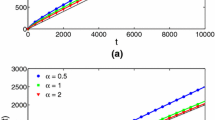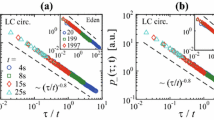Abstract
In the renewal processes, if the waiting time probability density function is a tempered power-law distribution, then the process displays a transition dynamics; and the transition time depends on the parameter \(\lambda \) of the exponential cutoff. In this paper, we discuss the aging effects of the renewal process with the tempered power-law waiting time distribution. By using the aging renewal theory, the p-th moment of the number of renewal events \(n_a(t_a, t)\) in the interval \((t_a, t_a+t)\) is obtained for both the weakly and strongly aged systems; and the corresponding surviving probabilities are also investigated. We then further analyze the tempered aging continuous time random walk and its Einstein relation, and the mean square displacement is attained. Moreover, the tempered aging diffusion equation is derived.













Similar content being viewed by others
References
Scher, H., Montroll, E.W.: Anomalous transit-time dispersion in amorphous solids. Phys. Rev. B 12, 2455–2477 (1975)
Naftaly, A., Edery, Y., Dror, I., Berkowitz, B.: Visualization and analysis of nanoparticle transport and ageing in reactive porous media. J. Hazard. Mater. 299, 513–519 (2015)
Barkai, E., Metzler, R., Klafter, J.: From continuous time random walks to the fractional Fokker–Planck equation. Phys. Rev. E 61, 132–138 (2000)
Barkai, E.: CTRW pathways to the fractional diffusion equation. Chem. Phys. 284, 13–27 (2002)
Shlesinger, M.F.: Asymptotic solutions of continuous-time random walks. J. Stat. Phys. 10, 421–434 (1974)
Pfister, G., Scher, H.: Non-Gaussion transient transport in disordered solids. Adv. Phys. 27, 747–798 (1978)
Klafter, J., Zumofen, G.: Lévy statistics in a Hamiltonian system. Phys. Rev. E 49, 4873–4877 (1994)
Vardeman, C.F., Gezelter, J.D.: Comparing models for diffusion in supercooled liquids: the eutectic composition of the Ag-Cu alloy. J. Phys. Chem. A 105, 2568–2574 (2001)
Stefani, F.D., Hoogenboom, J.P., Barkai, E.: Beyond quantum jumps: blinking nanoscale light emitters. Phys. Today 62, 34–39 (2009)
Monthus, C., Bouchaud, J.-P.: Models of traps and glass phenomenology. J. Phys. A 29, 3847–3869 (1996)
Barkai, E., Cheng, Y.-C.: Aging continuous time random walks. J. Chem. Phys. 118, 6167–6178 (2003)
Brokmann, X., Hermier, J.-P., Messin, G., Desbiolles, P., Bouchaud, J.P., Dahan, M.: Statistical aging and nonergodicity in the fluorescence of single nanocrystals. Phys. Rev. Lett. 90, 120601 (2003)
Schulz, J.H.P., Barkai, E., Metzler, R.: Aging effects and population splitting in single-particle trajectory averages. Phys. Rev. Lett. 110, 020602 (2013)
Mantegna, R.N., Stanley, H.E.: Stochastic process with ultraslow convergence to a Gaussian: the truncated Lévy flight. Phys. Rev. Lett. 73, 2946–2949 (1994)
Del-Castillo-Negrete, D.: Truncation effects in superdiffusive front propagation with Lévy flights. Phys. Rev. E 79, 031120 (2009)
Koponen, I.: Analytic approach to the problem of convergence of truncated Lévy flights towards the Gaussian stochastic process. Phys. Rev. E 52, 1197–1199 (1995)
Rosiński, J.: Tempering stable processes. Stoch. Process. Appl. 117, 677–707 (2007)
Stanislavsky, A., Weron, K., Weron, A.: Diffusion and relaxation controlled by tempered \(\alpha \)-stable processes. Phys. Rev. E 78, 051106 (2008)
Baeumer, B., Meerschaert, M.M.: Tempered stable Lévy motion and transient super-diffusion. J. Comput. Appl. Math. 233, 2438–2448 (2010)
Meerschaert, M.M., Roy, P., Shao, Q.: Parameter estimation for exponentially tempered power law distributions. Commun. Stat. Theory Methods 41, 1839–1856 (2012)
Sokolov, I.M., Chechkin, A.V., Klafter, J.: Fractional diffusion equation for a power-law-truncated Lévy process. Physica A 336, 245–251 (2004)
Meerschaert, M.M., Zhang, Y., Baeumer, B.: Tempered anomalous diffusion in heterogeneous systems. Geophys. Res. Lett. 35, L17403 (2008)
Allegrini, P., Aquino, G., Grigolini, P., Palatella, L., Rosa, A.: Generalized master equation via aging continuous-time random walks. Phys. Rev. E 68, 056123 (2003)
Bruno, R., Sorriso-Valvo, L., Carbone, V., Bavassano, B.: A possible truncated-Lévy-flight statistics recovered from interplanetary solar-wind velocity and magnetic-field fluctuations. Europhys. Lett. 66, 146–152 (2004)
Cairoli, A., Baule, A.: Anomalous processes with general waiting times: functionals and multipoint structure. Phys. Rev. Lett. 115, 110601 (2015)
Feller, W.: An Introduction to Probability Theory and Its Applications. Wiley, New York (1970)
Godrèche, C., Luck, J.M.: Statistics of the occupation time of renewal processes. J. Stat. Phys. 104, 489–524 (2001)
Schulz, J.H.P., Barkai, E., Metzler, R.: Aging renewal theory and application to random walks. Phys. Rev. X 4, 011028 (2014)
Dyke, P.: An Introduction to Laplace Transforms and Fourier Series. Springer, New York (2014)
Klafter, J., Sokolov, I.M.: First Steps in Random Walks: From Tools to Applications. Oxford University Press, Oxford (2011)
Oberhettinger, F., Badii, L.: Tables of Laplace Transform. Springer, Berlin (1973)
Krüsemann, H., Godec, A., Metzler, R.: First-passage statistics for aging diffusion in systems with annealed and quenched disorder. Phys. Rev. E 89, 040101(R) (2014)
Cherstvy, A.G., Metzler, R.: Population splitting, trapping, and non-ergodicity in heterogeneous diffusion processes. Phys. Chem. Chem. Phys. 15, 20220–20235 (2013)
Bertin, E.M., Bouchaud, J.-P.: Linear and nonlinear response in the aging regime of the one-dimensional trap model. Phys. Rev. E 67, 065105(R) (2003)
Froemberg, D., Barkai, E.: Time-averaged Einstein relation and fluctuating diffusivities for the Lévy walk. Phys. Rev. E 87, 030104(R) (2013)
Barkai, E.: Strong correlations between fluctuations and response in aging transport. Phys. Rev. E 75, 060104(R) (2007)
Allegrini, P., Aquino, G., Grigolini, P., Palatella, L., Rosa, A., West, B.J.: Correlation function and generalized master equation of arbitrary age. Phys. Rev. E 71, 066109 (2005)
Shemer, Z., Barkai, E.: Einstein relation and effective temperature for systems with quenched disorder. Phys. Rev. E 80, 031108 (2009)
Podlubny, I.: Fractional Differntial Equations. Academic Press, New York (1999)
Meerschaert, M.M., Sikorskii, A.: Stochastic Models for Fractional Calculus. De Gruyter, Berlin (2012)
Barkai, E.: Aging in subdiffusion generated by a deterministic dynamical system. Phys. Rev. Lett. 90, 104101 (2003)
Robert, C.P., Casella, G.: Monte Carlo Statistical Methods. Springer, New York (2004)
Acknowledgments
The authors thank Eli Barkai for the discussions. This work was supported by the Fundamental Research Funds for the Central Universities under Grant No. lzujbky-2015-77, and the National Natural Science Foundation of China under Grant No. 11271173.
Author information
Authors and Affiliations
Corresponding author
Appendices
Appendix 1: Generation of Random Variables (Fig. 1)
When generating the random variables with the PDF Eq. (1) to plot Fig. 1, the Monte Carlo statistical methods [42] is used. We first rewrite \(\varphi (t)\) as \(\varphi (t)=H(t)f_1(t)\), where \(f_1(t)=\alpha t_{0}^\alpha t^{-\alpha -1}\) with \(t_0\) being a small number. Denote the maximum of H(x) as M. Then the algorithm can be described as:
-
1.
Generate a r.v. \(x_{f_{1}}\) with PDF \(f_{1}\) and a r.v. \(\xi \) being uniformly distributed in the interval [0, 1].
-
2.
Accept \(x_{f_{1}}\), if \(M\xi \le H(x_{f_{1}})\); otherwise, reject.
-
3.
Return to Step 1.
Appendix 2: Mittag-Leffler Function
The two-parameter function of the Mittag-Leffler type plays a very important role in the fractional calculus, being introduced by G.M. Mittag-Leffler and studied by A. Wiman [39]. The two-parameter Mittag-Leffler function is defined by the series expansion
with \(\alpha >0\) and \(\beta >0\). Its one-parameter form (\(\beta =1\)) is given as
The asymptotic expansions of Mittag-Leffler are important for obtaining the various useful estimates of the long time or short time fractional dynamics. For small z, there exists
in the special case, \( E_{\alpha }(z) \sim 1+\frac{z}{\Gamma (\alpha +1)}\). Another important and useful formula is the asymptotic expansion of large scale for the Mittag-Leffler function. For \(0<\alpha <2\), \(\beta \) is an arbitrary complex number and \(\mu \) is an arbitrary real number such that \(\pi \alpha /2< \mu < \min \{ \pi , \pi \alpha \}\), then for an arbitrary integer \(p\ge 1\), the following expansion holds,
with \(z\rightarrow \infty \) and \(\arg (z) \le \mu \). For \(z\rightarrow +\infty \), from Eq. (70), we have
And if \(z\rightarrow -\infty \),
when \(\alpha =\beta \), we have \(|\Gamma (0)|\rightarrow \infty \). Therefore \( E_{\alpha ,\alpha }(z)\sim -\frac{1}{z^2 \Gamma (-\alpha )}\).
In the analysis of this paper, we use the following function several times.
When \(z \rightarrow +\infty \), from (71), there exists
see Fig. 14.
While for \(z \rightarrow 0\), from (69), we have \(g(z) \sim 1/\Gamma (\alpha )z^{\alpha -1}\).
Appendix 3: Laplace Transform of \(\varphi (t)\)
Here we present the Laplace transform of Eq. (1). From the definition of the survival probability on a site, i.e., the probability that the waiting time on a site exceeds t,
Using the definition of incomplete Gamma function, for Eq. (1) we have
According to the Laplace transform of the incomplete Gamma function \(\mathcal {L}[\Gamma (-\alpha ,\lambda t)]= \Gamma (-\alpha )[1-(\frac{u+\lambda }{\lambda })^\alpha ]/u\) with \(\mathfrak {R}e(-\alpha )>-1\) and \(\Psi (t)\), we have
which can also be obtained by using the Laplace transform of the one side stable law with a shift. From Eq. (77), we have two useful asymptotics. For the long time scale, \(t \gg 1/\lambda \), (i.e., \(u \ll \lambda \)) by the Taylor expansion, we have
Notice that \(\hat{\varphi }(0)=1\), so the PDF is normalized. From the definition of \(\langle \tau ^{n} \rangle =\int _{0}^{\infty } \tau ^{n} \psi (\tau )d\tau \), we can get \(\langle \tau \rangle =\alpha \lambda ^{\alpha -1}\), and \(\langle \tau ^2 \rangle =(1-\alpha )(-\alpha )\lambda ^{\alpha -2}\). For the general cases, \(\langle \tau ^n \rangle =-\Gamma (n-\alpha )/\Gamma (-\alpha )\lambda ^{\alpha -n}\), i.e., \(\hat{\varphi }(u) \sim 1-\langle \tau \rangle u+\langle \tau ^2 \rangle u^2+\cdots +(-1)^n\langle \tau ^n \rangle u^n\). For short time scale, \(t_{0}\ll t \ll 1/\lambda \) (i.e. \(u \gg \lambda \)), we have
Rights and permissions
About this article
Cite this article
Deng, W., Wang, W., Tian, X. et al. Effects of the Tempered Aging and the Corresponding Fokker–Planck Equation. J Stat Phys 164, 377–398 (2016). https://doi.org/10.1007/s10955-016-1547-3
Received:
Accepted:
Published:
Issue Date:
DOI: https://doi.org/10.1007/s10955-016-1547-3





